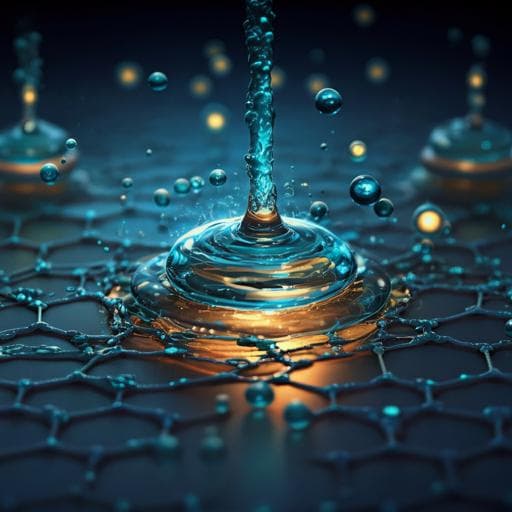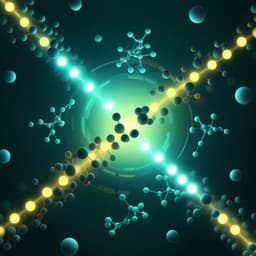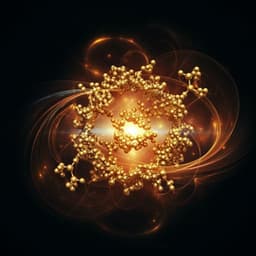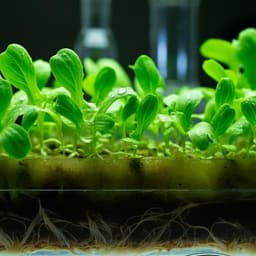
Chemistry
Effect of ion-specific water structures at metal surfaces on hydrogen production
Y. Tian, B. Huang, et al.
Discover how the presence of alkali metal cations dramatically alters water structure at electrolyte/electrode interfaces, influencing electrochemical reactions. This groundbreaking research, conducted by Ye Tian, Botao Huang, Yizhi Song, Yirui Zhang, Dong Guan, Jiani Hong, Duanyun Cao, Enge Wang, Limei Xu, Yang Shao-Horn, and Ying Jiang, reveals new insights into hydrogen evolution kinetics through innovative visualization techniques.
~3 min • Beginner • English
Introduction
The microscopic structure of the electrical double layer (EDL) at electrode/electrolyte interfaces governs selectivity and kinetics across electrochemical reactions. The classical Gouy-Chapman-Stern (GCS) model, comprising a compact Stern layer and a diffuse layer, provides a mean-field description but cannot capture molecular-scale water orientation, ion-specific effects, overcharging, or water orientational asymmetry. Alkali metal cations in particular can alter interfacial solvation and active sites, impacting proton-coupled electron transfer (PCET) barriers in hydrogen evolution/oxidation reactions (HER/HOR) and mass transport in oxidation reactions. While vibrational spectroscopies (SERS, SEIRAS) and diffraction methods have yielded insights into interfacial structure, they suffer from limited spatial resolution and spectral assignment challenges. Recent noncontact AFM with CO-terminated tips has enabled real-space visualization of hydrated ions and water structures at atomic resolution, opening opportunities to interrogate ion-water interactions at electrified interfaces. In this work, we investigate alkali cation–water networks on a charged Au(111) surface as a model of the Stern layer, aiming to elucidate ion-specific water structures at the atomic scale and connect them to HER kinetics.
Literature Review
The GCS model has long described EDL structure but lacks molecular specificity, failing to explain ion-specific effects, overcharging, and water orientational asymmetry. Vibrational spectroscopies, including SERS and SEIRAS, have probed water dipole orientation and hydrogen-bonding near electrified interfaces, while diffraction and x-ray absorption studies have examined ordering and layering in double layers. However, these techniques are limited by spatial resolution and spectral assignment. Advances in high-resolution AFM/STM, particularly with CO-functionalized tips, have visualized Na hydrates, hydronium-water layers, and alkali ion-water chains, suggesting the feasibility of imaging ion-water networks and hydration shells with atomic precision. Prior electrochemical studies have shown cation- and pH-dependent HER/HOR kinetics on noble metals, implicating interfacial water reorganization as a key descriptor. Together, these works motivate direct, real-space identification of ion-specific water structures at metal surfaces and their correlation with reactivity.
Methodology
Model system preparation: Alkali metal atoms (Li, K, Cs) were deposited onto clean Au(111) at room temperature, then water was dosed at ~120 K to form cation–water overlayers. Due to lower work functions of alkali metals relative to Au(111), electrons transfer to the Au, rendering alkali atoms cationic and the substrate negatively charged, simulating an electrified interface.
Microscopy: High-resolution scanning tunneling microscopy (STM) and noncontact atomic force microscopy (AFM) were conducted at 5 K using CO-terminated tips on custom qPlus sensors (k0 ~1800 N m−1, f0 ~28.7 kHz, Q ~1e5). Constant-current STM and constant-height AFM frequency-shift (Δf) imaging were employed. A varying-height AFM protocol was developed to resolve lower-lying water networks beneath higher features by approaching the tip within a current threshold.
AFM simulations: A flexible probe-particle model incorporating electrostatics and Lennard-Jones interactions was used to simulate Δf images. A quadrupolar charge distribution at the CO tip apex (q = −0.1 e) and electrostatic potentials from DFT were included; oscillation amplitude was 100 pm.
DFT calculations: VASP with PAW pseudopotentials and a 550 eV planewave cutoff was used, including van der Waals density functionals. Au(111) slabs of four layers (top layer relaxed) and appropriate supercells/k-point meshes were constructed for each cation system. Geometry optimizations used a 0.01 eV Å−1 force criterion and Bader charge analysis. Dipole corrections and >16 Å vacuum were applied.
SEIRAS: In situ surface-enhanced IR absorption spectroscopy was performed on Au films on Si prisms in H2-saturated electrolytes across pH 1, ~6–7, and 13. Spectra (500–4000 cm−1, 4 cm−1 resolution) were collected from potentials near PZC down to HER-relevant potentials; reference spectra were recorded at 1.1 V_RHE. OH stretching bands were deconvoluted into components at ~3600 cm−1 (isolated/weakly H-bonded), ~3450 cm−1 (asymmetric H-bonded), and ~3240 cm−1 (symmetric H-bonded, ice-like).
Electrochemistry: HER polarization curves were measured on polycrystalline Au rotating disk electrodes (RDE, 0.196 cm2) at 10 mV s−1 and 2500 rpm in H2-saturated electrolytes at 293 K: pH 1 (0.1 M HClO4 with 0.05–0.1 M MClO4 or 0.1 M MCl for Li, Na, K, Cs), near-neutral (0.05–0.1 M MClO4), and pH 13 (0.1 M MOH). iR compensation was applied. Exchange current densities and reorganization energies were extracted using Marcus–Hush–Chidsey (MHC) formalism; interfacial static dielectric constants were estimated by a Born model for reorganization energy.
Surface charge correlation: DFT-estimated negative surface charge densities on Au(111) under STM/AFM conditions (−0.15 Å−2 for Li+-water and −0.20 Å−2 for Cs+-water) were related to electrode potentials using the Gouy–Chapman–Stern model, aligning with pre-HER potentials in SEIRAS.
Key Findings
Real-space imaging and modeling of ion-specific cation–water networks on Au(111) reveal distinct structures across Li+, K+, and Cs+:
Cs+-water: STM shows 2D islands comprising single-stranded zigzag Cs+ chains linked by water rings. Height profiles indicate monolayer character with apparent heights ~1.7 Å (water) and ~2.2 Å (Cs+). AFM at large tip heights shows Cs+ as depressions (electrostatics with CO tip) and water as bright features; at lower heights, Cs+ appears as protrusions and H-bonds as sharp lines. A DFT-validated model (cation:water ~1:7, ~8 M) shows each Cs+ hydrated by five water molecules; two water molecules bridge adjacent cations. Predominant H-down water orientation is observed owing to the negatively charged surface; some flat-lying waters sit higher and appear bright. Water hexagons form between Cs+ chains but the H-bond network is highly distorted: O–O distances 265–300 pm and bond angles 93–136°.
Li+-water: STM reveals double-stranded Li+ chains interconnected by a honeycomb water network with larger corrugation than Cs+. AFM indicates an additional water adsorbed atop Li+ (H-up or flat orientations), producing bright/Y-shaped features. A varying-height AFM method resolves a hexagonal, ice-like water structure between Li+ chains. The structural model (1:12 cation:water, ~5 M) has Li+ adsorbed at bridge sites between two waters, elevated above the surface, hydrated by three waters, and minimally disturbing the hexagonal network; an extra water monomer on top accounts for corrugation. Water molecules favor H-down orientation.
K+-water: At ~1:6 (~9 M), K+ is hydrated by four waters, forming compact chains via shared waters like Cs+, but assembling only into short, randomly oriented chains. K+ chains are linked by a honeycomb H-bond network akin to the Li+ case, consistent with intermediate interaction strength.
Comparative trends (Li+ → K+ → Cs+): (1) First-shell hydration number increases (3 → 4 → 5). (2) Cation–surface separation decreases, with K+ and Cs+ contacting the surface directly, implying potential site-blocking. (3) Cation-induced disturbance of the H-bond network increases: Li+ acts as a structure-maker (ice-like), Cs+ as a structure-breaker (distorted network), K+ intermediate. Similar behavior is observed for double-layer structures at lower surface concentrations.
SEIRAS: At pH 13, OH-stretch intensity increases with more negative potentials (greater interfacial field). Deconvolution at −0.6 V_RHE shows cation-dependent fractions: Cs+ enriches the ~3600 cm−1 isolated water component (weakly H-bonded), Li+ enriches the ~3240 cm−1 symmetric H-bonded component (ice-like), with K+ intermediate. Similar trends are observed at pH ~6–7 and pH 1.
HER kinetics: On Au RDE across pH 1, ~6–7, and 13, exchange current densities follow Li+ > Na+ > K+ > Cs+. Weakly hydrated cations (K+, Cs+) accumulate near the negatively charged surface, inhibiting HER at higher overpotentials by active-site blocking and disrupting the interfacial H-bond network; they can modestly promote HER at low overpotentials. pH dependence shows j0 highest at pH 1, lower at pH 13, and lowest near-neutral due to proton transport limitations. Using MHC and the Born model, reorganization energy and interfacial static dielectric constant increase from Li+ to Cs+, correlating with the fraction of isolated water (e.g., at −0.2 V_RHE) and with reduced HER activity.
Electrostatics/potential alignment: DFT-derived surface charge densities correspond to ~−0.45 V vs PZC (Li+) and ~−0.3 V vs PZC (Cs+), linking UHV imaging conditions to pre-HER potentials in solution.
Discussion
The study addresses the atomic-scale origin of ion-specific effects in the Stern layer and connects these structures to HER kinetics. Structure-making cations like Li+ retain solvation and are elevated from the Au surface by an intervening ice-like water layer, preserving a symmetric H-bond network that is less responsive to potential changes, lowering the interfacial dielectric constant and reorganization energy. This environment facilitates PCET in the Volmer and Heyrovsky steps, enhancing HER exchange currents. In contrast, structure-breaking cations like Cs+ adsorb directly, displacing interfacial water, producing isolated/weakly H-bonded water molecules with distorted H-bond geometries, thereby increasing the interfacial dielectric constant and reorganization energy and impeding proton transfer. K+ exhibits intermediate behavior. SEIRAS confirms that Li+ promotes symmetric H-bonded (ice-like) water, while Cs+ promotes isolated water at negatively charged Au. Electrochemical measurements reveal that HER kinetics mirrors these interfacial solvation trends across pH, with additional pH-dependent effects tied to interfacial water structure and proton availability. The integrated STM/AFM, SEIRAS, DFT, and kinetic modeling thus provide a coherent picture linking spectator ion identity to interfacial water structure and reaction kinetics.
Conclusion
By imaging and modeling alkali cation–water networks on negatively charged Au(111), this work reveals that Li+ is lifted from the surface by an ice-like water layer and acts as a structure maker, whereas K+ and Cs+ contact the surface and increasingly disrupt interfacial water, with Cs+ acting as a structure breaker. These ion-specific structures are corroborated by SEIRAS and directly correlate with HER kinetics via changes in interfacial dielectric properties and reorganization energy. The findings underscore the critical role of spectator cations in defining interfacial solvation and electrochemical activity. Future work can extend these approaches to diverse cations and anions, different electrode surfaces, and multilayer water structures. Advances such as qPlus AFM on ice Ih and fast transient heating/refreezing integrated with AFM may enable capturing liquid-like states and dynamics, providing further insights into ion-specific multilayer structures and time-dependent interfacial phenomena.
Limitations
The STM/AFM experiments were conducted under ultrahigh vacuum at cryogenic temperature (5 K) on a model Au(111) system with high surface ion concentrations, which may not fully capture thermal fluctuations and dynamics at ambient liquid/solid interfaces. While strong cation–surface interactions suggest qualitative relevance to in situ conditions and SEIRAS shows consistent trends, the lifetimes and exact configurations of interfacial structures may differ in solution. Additionally, polycrystalline Au in electrochemical and SEIRAS measurements may introduce facet averaging relative to the single-crystal Au(111) model.
Related Publications
Explore these studies to deepen your understanding of the subject.







